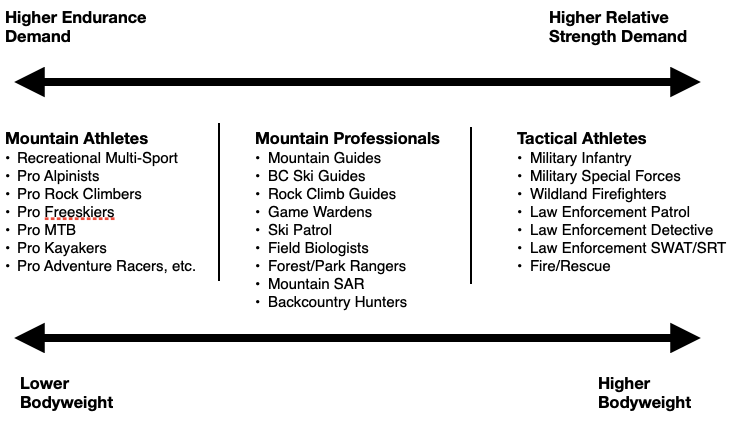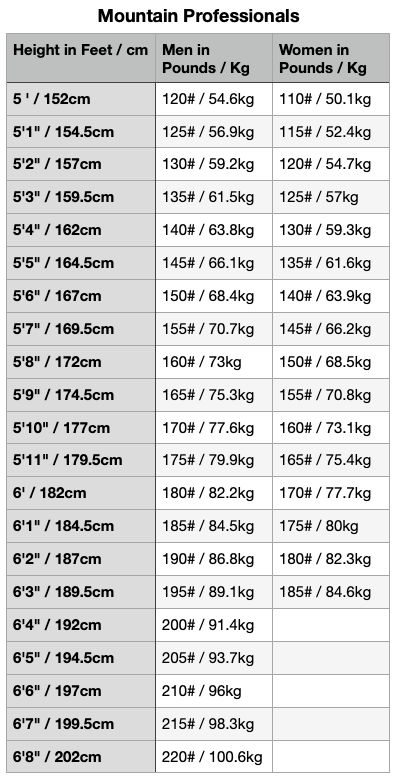By Rob Shaul
For years I’ve answered questions from individual mountain and tactical athletes and/or given unsolicited advice on a target bodyweight based on height, but until now, I’ve never formalized these ideal bodyweight targets.
Everything MTI does is focused on improving and/or maximizing performance, and the same is true for the height vs. bodyweight charts below.
From a performance perspective, both mountain and tactical athletes have a wide range of mission-direct fitness demands. On one end of the fitness spectrum is movement over ground loaded endurance. On the other end is a high relative strength – or strength per bodyweight. In the middle are demands for multi-modal, intense, short-duration (<30 min) work capacity, chassis integrity (functional core) and tactical agility for tactical athletes.
From a bodyweight perspective, strength and endurance work against each other. One key element of traditional strength training is hypertrophy – or added muscle, which means added weight. For endurance athletes, every excess ounce of muscle which isn’t helping with movement is just extra load to carry, and thus slower movement.
My challenge in identifying ideal bodyweight for mountain and tactical athletes is to meet in the middle between these two ends of the spectrum – allow for enough muscle mass for all around, high relative strength, yet not so much mass that it significantly hampers endurance because of unneeded weight.
Strength and Endurance Demands by Athlete Type – Mountain Athletes vs Mountain Professionals vs Tactical Athletes
Acknowledging that Mountain Athletes, Mountain Professionals and Tactical Athletes all have similar work capacity and chassis integrity demands, what separates them in terms of fitness programming and thus, ideal bodyweight, is strength and endurance demands.
Tactical Athletes have a higher strength demand than Mountain Athletes because of load carriage. A pro alpinist will strip his equipment to the lightest possible to go light and go fast. It’s not unusual for pro alpinists to attack peaks on overnight trips with packs 25-pounds or less. My personal 2-3 night backcountry hunting pack weighs under 25#, before water.
A soldier’s ruck weight begins at 45 pounds, often before food and water, and this load does not include 25 pounds of body armor and ammo, 8-pound helmet and 10 pounds carbine. Ruck weights on long FTXs, and military schools like Ranger and Sapper can reach up to 100 pounds.
Even LE Patrol can carry 25 pounds in body armor and duty belt equipment.
Turnout gear and breathing apparatus for urban firefighters can approach 70 pounds and Wildland Fire hotshot crews carry 45-pound packs plus a helmet, chain saw or some other hand tool. Smoke jumps will parachute into fight fires with 90# packs and other gear.
All this external load means an increased relative strength (strength per bodyweight) demand. More strength generally means more muscle, which means more mass/weight.
Mountain athletes generally have a higher endurance demand than tactical athletes. Most mountain missions begin with an approach of some type and many, like mountain biking, backcountry skiing, peak bagging, etc. are an endurance effort beginning to end.
In contrast, the endurance demands for tactical athletes are not as predictable. The military deployment to the mountainous region of Afghanistan may take significant endurance because of long mountain patrols, while a deployment to an urban area like Syria may not as movement will be by vehicle.
Things are more nuanced for law enforcement.
Urban SWAT/SRT teams primarily get to the mission via vehicle, but occasionally are called out on rural missions and/or manhunts where significant endurance is required.
LE Patrol/Detectives generally don’t have a strong mission-direct endurance demand, but upper body mass (big chest and biceps) can act as a deterrent to would-be bad guys, and MTI LE Patrol/Detective programming includes upper body hypertrophy.
Between Mountain Athletes and Tactical Athletes are the Mountain Professionals – Game Wardens, Ski Patrol, Mountain Guides, SAR, etc.
Mountain Professional mission sets, like mountain athletes, always have a significant endurance demand. However, the loads they carry are greater. While a pro alpinist can get buy with a 20# pack, a mountain guide’s pack will approach 45# as he/she needs to carry a first aid kit, extra food/water equipment needed to care for any client issues that arise.
Also in this category are Backcountry Hunters – whose pack weight can approach 150-pounds when packing game out.
MTI already accommodates for the difference in mission-direct strength and endurance demands between mountain and tactical athletes through programming. In general, the base fitness program design for mountain athletes has more endurance, and the base fitness program design for tactical athletes has more strength.
Specifically to relative strength, the MTI Relative Strength Standards for mountain athletes and tactical athletes are also different. See HERE for our MTI Relative Strength Assessment and the athlete-specific scoring charts. We don’t expect lighter, mountain athletes, to be as strong in terms of relative strength (strength per bodyweight) as tactical athletes.
Ideal Bodyweights By Athlete Type and Height
See the charts below for MTI’s ideal bodyweights by athlete type and height.
For each chart, a 1-inch increase in height results in a 5-pound increase in ideal bodyweight.
I began this process with the BJ Devine Bodyweight formula he developed in 1974 to determine drug dosage. In looking at Devine’s chart, it matches closely what I’d observed and recommended for Mountain Athletes over the years and so his chart/formula is what I used for Mountain Athletes.
Each inch of height increase results in a 5-pound increase in ideal bodyweight.
The difference between the charts above is where they start out. For the same height, Mountain Professionals can be 10-pounds heavier than Mountain Athletes, and Tactical Athletes can be 5 pounds heavier than Mountain Professionals.
Again, these ideal bodyweights are based on the endurance and strength fitness demands of each athlete type, but also what I’ve seen anecdotally over 15 years in working with all of these athlete communities, especially when it comes to relative strength, or strength per bodyweight.
Not heavy enough for your athlete type? Take MTI’s Relative Strength Assessment and see where you score. If you score “poor” it’s time to do a strength cycle and increase protein intake.
Too heavy? Either you’re carrying too much fat, or too much muscle. Take MTI’s Relative Strength Assessment and see where you score. Understand that there are two ways to increase your relative strength score …. increase strength or decrease bodyweight.
If you score super high on the strength assessment, you’ve likely been training too much strength, and could stand to cut some muscle. Your endurance may have suffered. Take the appropriate MTI endurance assessment for your Athlete Type and see how you score.
If you don’t score high on the strength assessment, you need to lose some fat. You can’t outwork a shitty diet …. and 90% + of fat loss is nutrition-related. Clean up your diet and you’ll shed fat.
HERE are our nutritional recommendations.
Feedback/Comments? Please use the comment section below.
You Might Also Like 4 Weeks on a “Keto-ish” Diet




